It is much easier than you think to get enough protein on a plant-based diet. This guide includes 20 low-cost vegan protein meals, tips for how to get enough protein, and debunks common myths about this essential macronutrient.
Ninety-seven percent of Americans get enough protein. Whether you eat meat or not, it is much more likely you are exceeding your daily protein requirement than not meeting it.
Protein is in practically every food. It is almost impossible to design a diet of whole plant foods that is sufficient in calories but deficient in protein.
Jump to:
🧱 What is Protein?
Protein is one of the three major macronutrients, along with carbohydrates and fat. It is in muscle, bone, hair, skin, and almost every other bodily tissue. It is made up of building blocks called amino acids. There are over 20 amino acids, and they fall into two main categories: essential and nonessential.
Essential amino acids:
Essential amino acids are the ones that the body cannot make on its own. Therefore, they must come from food. There are nine essential amino acids.
Nonessential amino acids:
Nonessential amino acids are the ones that the body can make on its own.
These Cashew Tofu Lettuce Wraps are rich in all the essential amino acids.

🍃 Are Plant Proteins Complete?
Complete proteins are foods with all nine essential amino acids. A common myth is that plant proteins do not contain all the essential amino acids. However, this is not the case. All plant-based proteins in the food supply provide all nine essential amino acids.
Although some may contain lower amounts than others, there is no need to combine plant proteins to make sure you get enough of each. This is because the body maintains pools of excess amino acids and does the complementing for you.
The plant foods highest in all nine essential amino acids include tofu, edamame, tempeh, miso, nutritional yeast, and quinoa.
Quinoa is a good source of protein and fiber. Try this easy Vegan Mexican Quinoa Bake recipe.
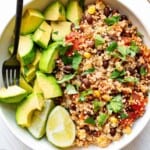
💪🏼 Why Do You Need Protein?
Protein is important for growth, as well as tissue repair and development. It carries oxygen throughout the body, helps make antibodies to fight off infection and disease, keeps cells healthy, and supplies energy.
Without enough protein, the body is not able to rebuild properly and starts to lose muscle mass.
Tempeh is rich in iron and all nine essential amino acids. Try this Tempeh Lentil Stew with Potatoes recipe.
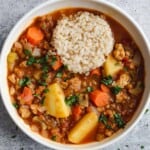
🙋🏽♀️ How Much Protein Do You Need?
The average protein requirement is about 42 grams per day. The National Academy of Medicine recommends adults consume about 0.36 grams per pound, or 0.8 grams per kilogram, of body weight per day. This translates to about 7 grams for every 20 pounds of body weight.
On average, vegans and vegetarians get 70 percent more protein than they need every day.
Try this Avocado White Bean Sandwich made with nutritional yeast. Nutritional yeast is rich in all nine essential amino acids as well as vitamin B12.
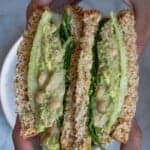
🍖 Is It Bad to Eat Too Much Protein?
While it is important to include protein in your diet, you might not need as much as you think, and there are downsides to consuming too much.
Excessive protein intake is associated with:
- Increased cancer risk
- Bone disorders
- Impaired kidney function
- Liver disorders
- Worsening of coronary heart disease
- Early onset of puberty
Overconsumption of protein during pregnancy may result in:
- More premature births
- Increased risk of death and growth retardation
- Increased likelihood of children becoming overweight in later life
Folate can help prevent birth defects during pregnancy. Try this high-folate protein-rich Quinoa & Kale Salad Bowl with Maple Dijon Dressing.
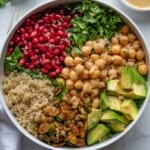
🥩 Is Meat Protein Better Than Plant Protein?
All essential amino acids originate from plants. Therefore, the nutrients present in animal protein come from the plants animals eat.
The fallacy that meat proteins are superior to plant proteins stemmed from the myth that plant proteins are incomplete, meaning they lack some of the essential amino acids. This myth was debunked a long time ago. As referenced in this National Institute of Health study, every plant protein in the food supply contains all nine essential amino acids.
Chickpeas are an excellent source of fiber and protein. Try this High-Protein Chickpea Quinoa Salad recipe.
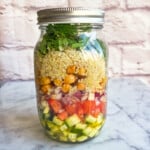
Consuming too much animal protein is associated with several health risks, including an increased risk of chronic kidney disease. In addition, high levels of animal protein on a weight loss diet may reduce the metabolic benefits of losing weight.
A diet rich in plant-based protein has not been shown to carry similar risks. In fact, replacing animal protein with plant protein provides many benefits. For example, it improves blood sugar control in diabetes.
Try these pantry-friendly vegan Easy 6-Ingredient Lentil Burgers for a quick weeknight dinner.
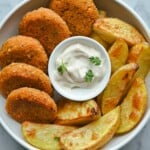
📦 The Protein Package
High-protein foods do not just contain protein, but also everything that comes along with it.
Unprocessed plant-based sources of protein typically contain fiber, heart-healthy fats, and phytochemicals –bioactive compounds including flavonoids, carotenoids, and polyphenols. Phytochemicals may lower the risk of chronic diseases including cancer and cardiovascular disease.
Meat-based sources of protein usually contain saturated fat, sodium, and no fiber.
Protein powders are not regulated by the U.S. Food and Drug Administration for safety, and often contain thickeners, added sugars, non-caloric sweeteners, and artificial colors and flavoring.
Therefore, plant-based proteins are the safest option. The recipes in this guide use the healthiest plant-based protein ingredients.
Try this Vegan Rice and Bean recipe with less than 2 grams of saturated fat.
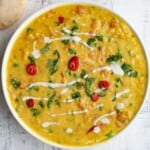
🌱 How to Make Vegan Protein Meals
The average Recommended Dietary Allowance (RDA) for protein in adults is around 42 grams per day. The following calculations are approximations based on this average.
🐔 Seitan (Wheat Meat)
Seitan is made from gluten, the main protein in wheat. It is low in calories, fat, and carbohydrates. Cooked seitan looks and tastes like meat, which is why it is a popular meat substitute for vegans and vegetarians.
A 3.5-ounce serving of seitan contains 25 grams of protein. (~60 percent of the RDA)
Try this delicious Easy Vegan Turkey made with seitan. It is an ideal plant-based Thanksgiving recipe.

🍗 Soy Curls
Soy curls are made from non-GMO, whole soybeans, grown without chemical pesticides. They are high in all nine essential amino acids, as well as fiber and iron. In addition, they are gluten-free.
Soy curls are tasteless on their own but easily absorb the flavors of sauces and marinades. When cooked, they taste just like chicken.
One serving of soy curls (¾ cup dry) contains 11g of protein. (~26 percent of the RDA)
Try this iron-rich Easy Soy Curl & Vegetable Stir-Fry. It is a meaty, flavorful, and family-friendly meal.
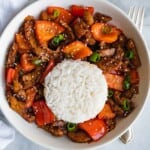
🍜 Tempeh, Tofu, and Edamame
These three protein-rich foods come from soybeans.
Edamame are immature soybeans. Tofu is made by coagulating soy milk and then pressing the resulting bean curds together into solid white blocks. Tempeh is made by fermenting mature soybeans, and then pressing them into a block.
They are high in fiber and heart-healthy fats. Plus, they are versatile and easy to prepare.
Tempeh
A 3-ounce serving of tempeh contains 18 grams of protein. (~43 percent of the RDA)
Try these easy & delicious Sun-Dried Tomato Tempeh Burgers.
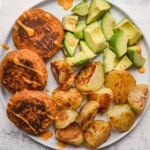
Tofu
Super firm tofu: A 3-ounce serving contains 14 grams of protein. (~33 percent of the RDA)
Firm tofu: A 3-ounce serving contains 8 grams of protein. (~19 percent of the RDA)
Medium firm tofu: A 3-ounce serving contains 6 grams of protein. (~14 percent of the RDA)
Silken tofu: A 3-ounce serving contains 4 grams of protein. (~10 percent of the RDA)
These Easy Vegan No-Chop Dumplings are made with rice paper and extra firm tofu.

Edamame
One-half cup serving of shelled edamame contains 8 grams of protein. (~19 percent of the RDA)
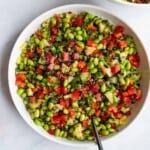
🍛 Legumes
Lentils
Lentils of all colors contain roughly the same amount of protein. They are also high in iron, fiber, and several other nutrients.
One-half cup serving of cooked lentils supplies about 12 grams of protein. (~29 percent of the RDA)
Try this easy 15-minute Lentil Veggie Curry recipe for a quick and flavorful weeknight dinner.

Beans & Chickpeas
Most varieties of beans are a good source of protein. Plus, they are high in fiber, iron, and several other nutrients.
One-half cup serving of cooked beans contains 8 grams of protein. (~19 percent of the RDA)
Double down on protein with this black bean and tofu chili.
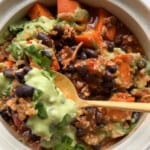
🍃 Nutritional Yeast
Nutritional yeast is a deactivated strain of Saccharomyces cerevisiae yeast. Sold as a yellow powder or flakes, it has a cheesy flavor and is a popular ingredient in vegan cooking. Fortified nutritional yeast is an excellent source of vitamin B12 and protein.
One half-ounce serving of nutritional yeast contains 8 grams of protein. (~19 percent of the RDA)
Try this B12-loaded nutritional yeast white bean recipe.
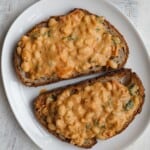
🥣 Quinoa
Quinoa is technically a seed, even though it is commonly referred to as a grain or pseudo-grain. It is gluten-free.
One ¾-cup serving of cooked quinoa contains 9 grams of protein. (~21 percent of the RDA)
Try this easy, budget, and pantry-friendly quinoa recipe.
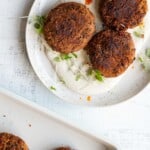
🥛 Soy Milk
Soy milk is made from soybeans, which are rich in all nine essential amino acids. In addition, most brands are fortified with vitamin D and B12. Opt for unsweetened soy milk whenever possible.
A serving size of 1 cup of soy milk contains 8 grams of protein. (~19 percent of the RDA)
Try this stew made with soy milk, tempeh, and white beans.
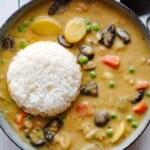
🍚 Wild Rice
Despite its name, wild rice is an aquatic grass. It contains double the amount of protein as brown rice.
One serving of cooked wild rice (1 cup) contains 6 grams of protein. (~14 percent of the RDA)
🌿 Hemp Hearts
Hemp hearts, or hemp seeds, are technically a nut. They have a mild, nutty flavor and are delicious in salads, sprinkled on avocado toast, mixed into sandwich spreads, and much more.
One 3-tablespoon serving of hemp hearts contains 10 grams of protein. (~24 percent of the RDA) Plus, they are high in iron, heart-healthy fats, and several other nutrients.
Try this nourishing iron-rich wild rice recipe with hemp hearts.
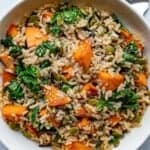
🌱 Chia Seeds
Chia seeds have a mild, nutty flavor that complements both sweet and savory dishes. Mix them into salad dressings, smoothies, baked goods, or granola. Or use them to make chia jam, or as a vegan egg substitute.
One 2-tablespoon serving of chia seeds contains 6 grams of protein. (~14 percent of the RDA) Plus, they are especially high in fiber, calcium, iron, and heart-healthy fats.
Try this fan-favorite chia pudding recipe.
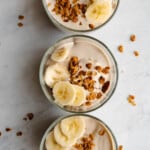
🥜 Nuts and Nut Butters
Nuts are a healthful source of protein, fiber, heart-healthy fats, iron, and several other nutrients. Blanching and roasting them can lower their nutritional value, so they are best eaten raw. Opt for natural nut butter without added oil, sugar, and salt.
One 2-tablespoon serving of nut butter contains 8 grams of protein. (~19 percent of the RDA)
Try this chickpea bowl made with nut butter and peanuts.
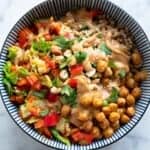
🥗 Protein-Rich Veggies and Fruit
Vegetables with the most amount of protein include spinach, Brussels sprouts, sweet potato, artichokes, broccoli, asparagus, corn (grain), and white mushrooms.
Fresh fruit generally have a lower protein content than vegetables. Those with the most protein include guava, avocado, jackfruit, apricot, kiwi, grapefruit, cherries, blackberries, raspberries, bananas, grapefruit, and oranges.
Try this veggie-loaded salad recipe.
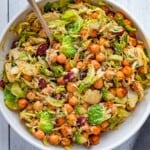
🎬 The Takeaway
A well-planned vegan diet provides all the protein your body needs. Consume protein-rich plant foods throughout the day to sustain your energy. Choose a well-balanced diet and include a variety of fruits, vegetables, legumes, whole grains, nuts, and seeds.
Use this guide with over 20 Vegan Protein Meals as a resource.
👩🏽🍳 Made These Recipes?
Leave a review and share your Vegan Protein Meal creation with me on Instagram. It makes my day to see you recreate my recipes.
I would love it if you would ⭐️ rate these recipes and leave a comment. Thank you in advance.

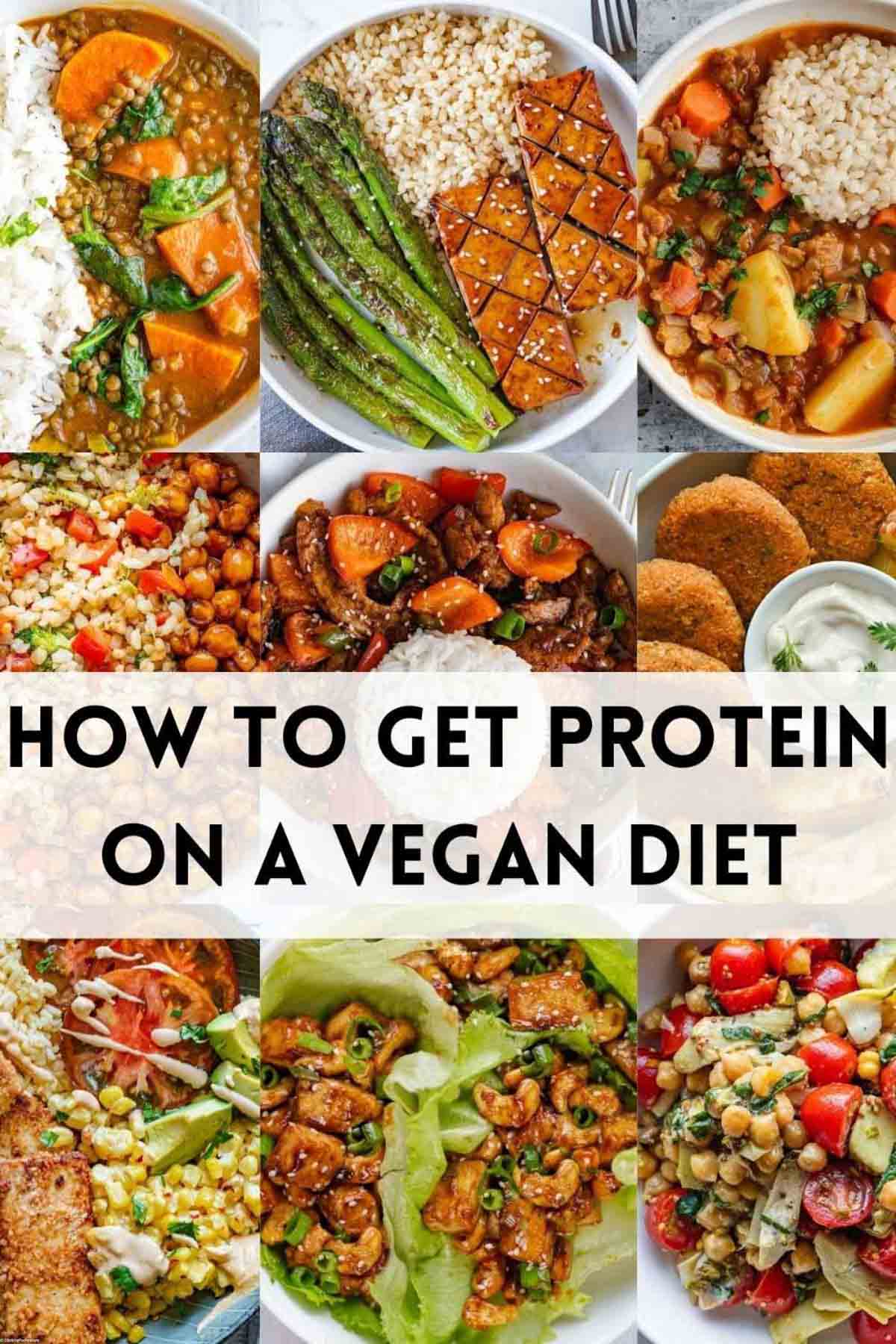
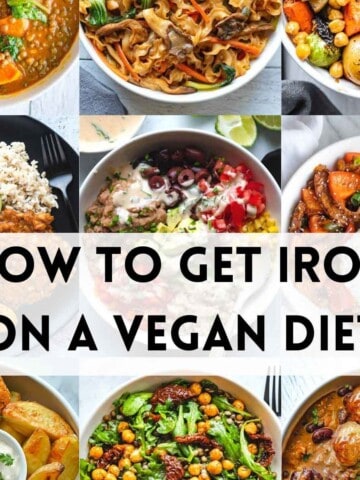
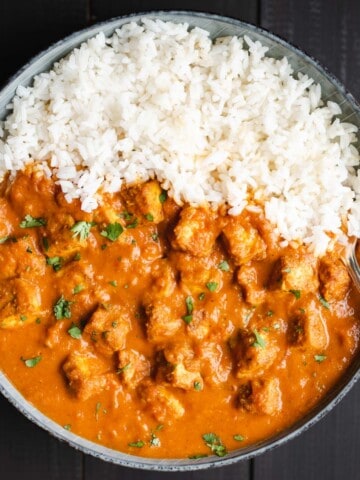
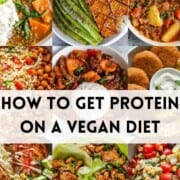
Sharon Nazarian aka That Snazzy Life
Awesome post, Nisha!! I just love your Instagram posts too!! Even though I've been following you for a while now, I haven't always seen your posts, thanks to the Insta algorithm. Just binge-watched a bunch of them. Hearted and favorited all of them too. 🙂 I need to get your book. Haven't bought a cookbook in a while, but am inspired to check out yours. Congratulations!!
Nisha Melvani
Thank you so much for your support. Have a wonderful evening.
Correen
Learned so many new things from reading this article. Thank you so much. Is there anyway to make up a PDF? I'd like to use it as a reference, scribble notes on it and try each one of the recipes from the guide. I'll look back in for a reply. ♥
Nisha Melvani
Thank you for taking the time to read it. I will look into providing a PDF soon. Have a great day.
Amina
I love this post because it is so comprehensive and it includes sample recipes. I sometimes worry I don’t have enough protein in my vegan diet so this is a very reassuring & useful guide. Thanks Nisha!
Nisha Melvani
Thanks for taking the to read it. Have a great day.